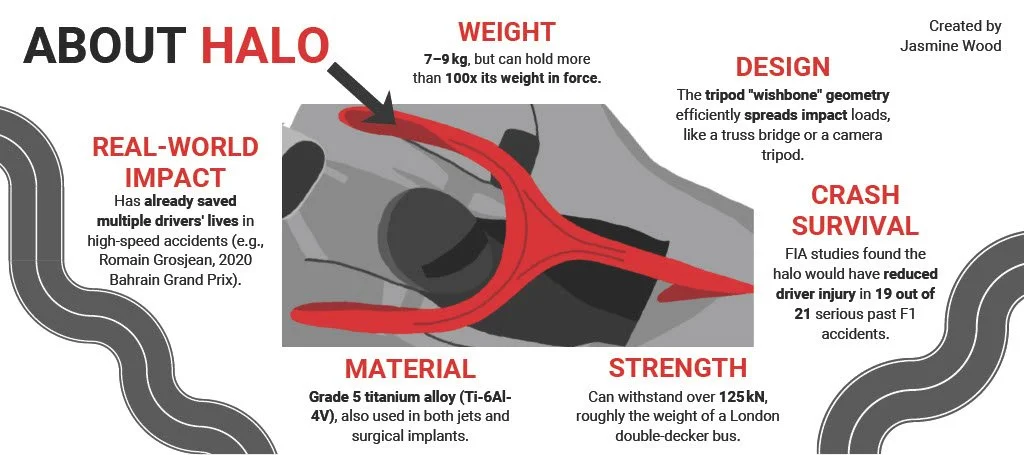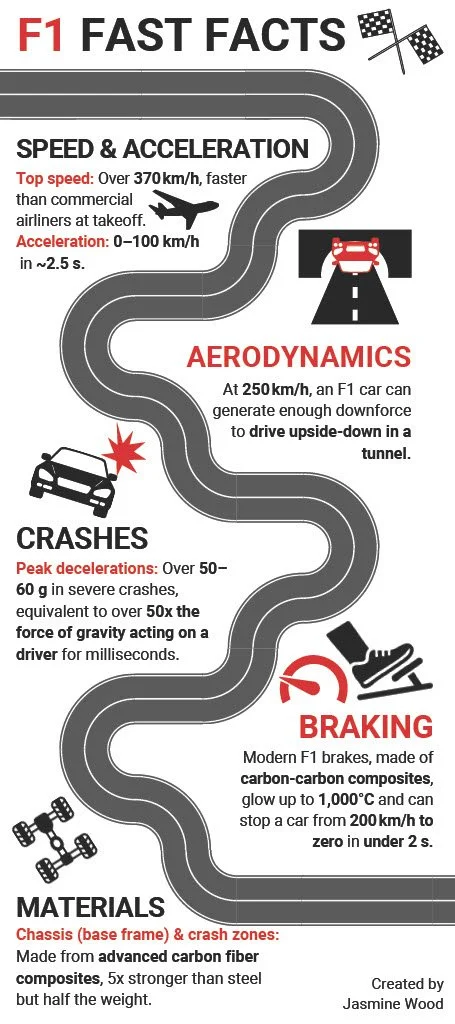But the halo only shines as part of a bigger system. Once the survival cell receives that load, energy-absorbing structures all around the car go to work. The nose and rear “crash cones” are designed to crumple in stages, like slowly crushing an empty can, bleeding off energy by tearing fibers and squashing honeycomb cores. Side-impact structures and anti-intrusion panels do similar work for lateral hits, while the survival cell itself is designed to be all but indestructible.
We can even go deeper into physics without having to learn some esoteric physics terms. Indeed, you need not know more than four terms that we use on a daily basis: force, momentum, impulse, and time. Crashes are governed by impulse: force over time changes momentum. If a car’s change in momentum is fixed, increasing the time over which that change happens reduces the average force on the driver (F = Δp/Δt). That’s why modern road cars crumple and airbags deform easily. They buy milliseconds, clipping the peak forces your body faces. F1 applies the same principle at much higher energies.
Let’s go back to the halo. Because its job is to block intrusions and transfer load safely, it must be both sturdy and light. That’s why it’s made from aerospace-grade titanium alloy (Grade 5, Ti-6Al-4V). Titanium is roughly 40–45% lighter than steel for comparable strength and has a lower elastic modulus, meaning it’s less stiff than steel, which helps with distributing loads without brittle failure. The result: a compact, ~seven kg structure with an exceptional strength-to-weight ratio that integrates cleanly with the carbon monocoque.
F1: The Movie dramatizes the terror of a high-speed crash, but the reason a driver like Joshua Pearce plausibly survives is no fiction. Modern F1 safety blends a titanium halo that blocks intrusions, a near-indestructible carbon survival cell, and sacrificial structures that turn kinetic energy into torn fibers and crumpled honeycomb, stretching impact time to slash peak forces. That layered approach is why real-world outcomes have improved so markedly since 2018. The tech may be invisible at 200 mph, but it’s the quiet star of every race.
Lifting Elephants with Flip Flop
Science behind halo, the guardian of increasingly popular motorsports
Written by: June Bae | Edited by: Morgan Nguyen | Infographic by: Jasmine Wood
During the COVID lockdowns, Netflix’s Drive to Survive helped move Formula One from niche to mainstream in the U.S. The wave crested again this past summer with F1: The Movie, featuring a fictional team, APXGP, and Brad Pitt as veteran driver Sonny Hayes. While the dramatic pace of the film parallels that of F1 racing cars, every audience member probably felt like the time stopped for a second when there was a violent crash involving rookie Joshua Pearce, played by Damson Idris. Many of us take his survival for granted. Movie heroes tend to walk away from grave dangers. But, real F1 safety hasn’t always been so forgiving. Until a few years ago, crashes that looked milder than Pearce’s could still be fatal.
So what’s different now?
After Jules Bianchi’s tragic accident at Suzuka in October 2014, the FIA accelerated a suite of safety measures. The most visible is the halo, made mandatory in 2018 across F1 and other single-seater series.
The halo is a rigid, U-shaped titanium frame with a front post and two rear legs; basically, a flip-flop strap of the cockpit. Surprisingly, however, its job isn’t to “soften” a blow like an airbag; it’s to keep wheels, wings, or barriers out of the driver’s headspace and route the load into the strongest part of the car: the carbon-fiber survival cell (the monocoque). In other words, the front post takes the first punch, the ring shares the load, and the three mounting points feed it into the chassis built to handle extreme forces. Teams and the FIA test halos to staggering levels on the order of holding an elephant's weight on a ~7 kg structure.
These articles are not intended to serve as medical advice. If you have specific medical concerns, please reach out to your provider.


